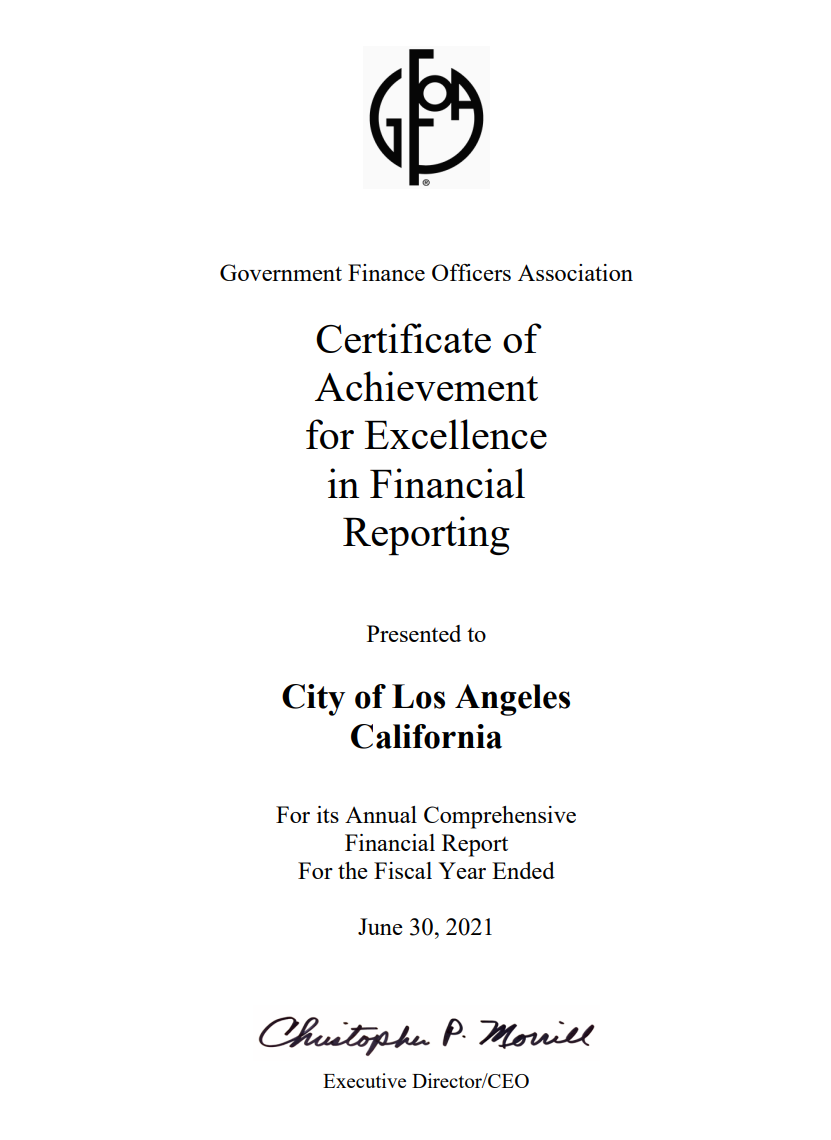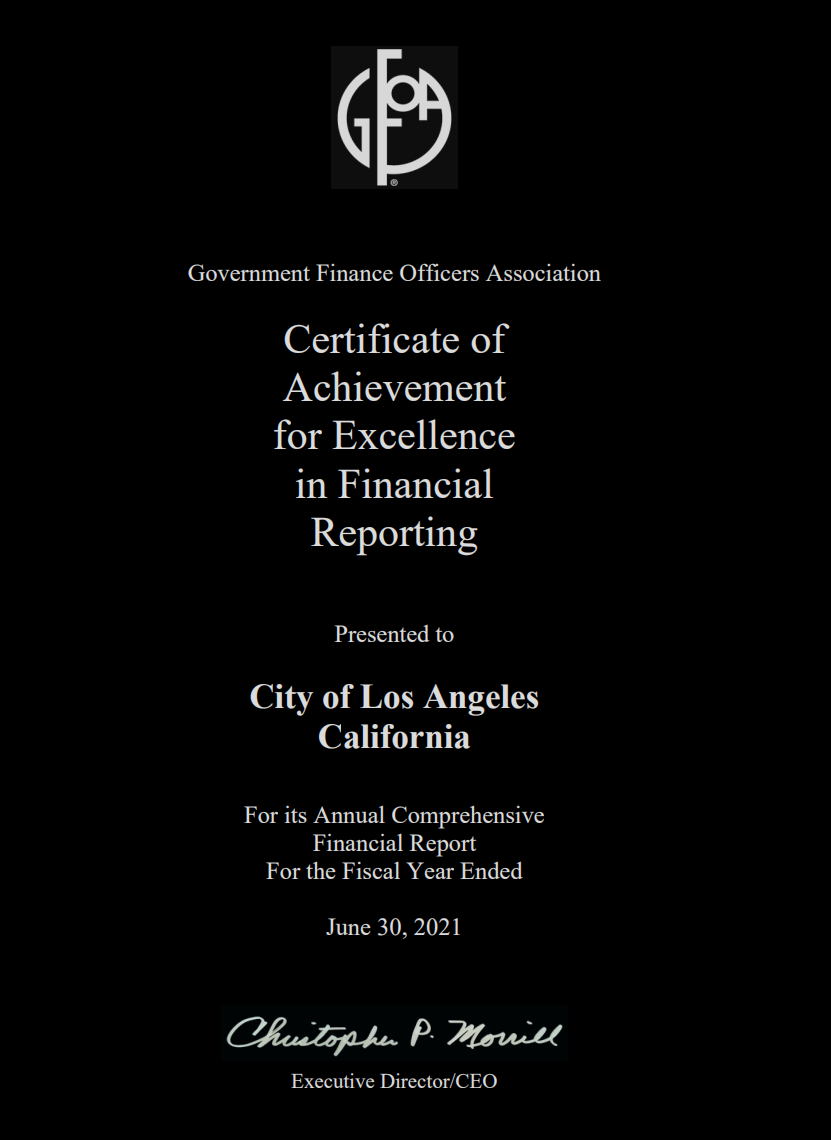Popular Annual Financial Report FY22
A summary of the City of Los Angeles Annual Comprehensive Financial Report for Fiscal Year ended June 30, 2022.
LA City Controller Kenneth Mejia releases the Annual Comprehensive Financial Report (ACFR) each January to provide a complete picture of the City’s finances. This website contains the Popular Annual Financial Report (PAFR), a summary of the ACFR that presents the information in a more accessible format, along with charts and graphs measuring how the City serves residents.
Click here for the full FY2022 Annual Comprehensive Financial Report
A Letter from City Controller Kenneth Mejia
Community Members of the City of Los Angeles As the new Controller for the City of Los Angeles, our Office has the Charter responsibility to prepare and publish the City's Annual Comprehensive Financial Report (ACFR) of the City for the fiscal year ended June 30, 2022.
As the new Controller for the City of Los Angeles, our Office has the Charter responsibility to prepare and publish the City's Annual Comprehensive Financial Report (ACFR) of the City for the fiscal year ended June 30, 2022.
We live in tumultuous times. The residents and businesses of Los Angeles have endured a once-in-a-century pandemic that upended lives and livelihoods throughout the City, falling hardest on the most vulnerable. Rising rents and housing prices have increased housing insecurity for tens of thousands of tenants and fueled a homelessness emergency. The impacts of the pandemic, inflation and international conflicts continue to disrupt supply chains around the world.
Amid deepening economic and political divides, Los Angeles is at the epicenter of these and even larger challenges, including the "planetary red alert" of climate change. Angelenos in the last election voted for change. It is our responsibility to respond with transparency and accountability.
The ACFR provides a report on revenues and expenses for all the City's funds, including the Harbor, Airports and Department of Water and Power and a snapshot of the fiscal condition of the City as it ended the fiscal year on June 30 of 2022.
- Total City revenues, including Governmental and Business-Type activities, were approximately $20.0 billion, an 8.7 percent increase over FY 2020-21.
- Total City expenses including Governmental and Business-Type activities, were approximately $16.6 billion, a decrease of 4.5 percent from FY 2020-21.
- The aggregate fund balances of the City's governmental funds were $7.3 billion, a net increase of $857.4 million from June 30, 2021.
- The Reserve Fund cash balance began FY 2022-23 at $601.7 million or 8.1 percent of General Fund Budget, down from an all-time high of $647.0 million at the beginning of Fiscal Year 2021-22.
- The City's bonded debt and long-term notes payable as of June 30, 2022, totaled $37.3 billion, an increase of $3.1 billion from the prior year's balance of $34.2 billion.
- The largest General Fund departmental expenditures (including encumbrances) went to Police ($1.8 billion); Fire ($780.2 million); and Sanitation ($330.6 million).
While the City is currently in a stable fiscal position, significant challenges lie ahead. The almost $2.0 billion in one-time revenue from the federal government available during the last two years has largely been spent. Retirement Plans' adverse investment returns during Fiscal Year 2021-22 will increase future pension costs, which now consume more than 15% of the General Fund budget. Increased labor costs put a further strain on resources to maintain and improve services to our residents. There is also universal recognition of the need to spend more to house the more than 42,000 unhoused residents of our community. Finally, Los Angeles has underinvested for decades in maintaining its capital and human infrastructure - which will come under intense test from the impacts of climate change.
All this impels us to
link arms(as Mayor Karen Bass has advocated) to undertake the difficult, long-term changes that will not only ensure financial stability, but address the urgent need to make Los Angeles a more equitable and sustainable city. We pledge that the Office of the Controller will be a collaborative partner in meeting those shared challenges.
I would like to acknowledge the professional and dedicated staff of the Financial Analysis and Reporting Division of the Controller's Office for the preparation of this report. I would also like to express my appreciation to other staff of the Office for their assistance and contributions, as well as other professional contributors citywide.
Respectfully submitted,
 Kenneth Mejia
Kenneth Mejia
Los Angeles City Controller
About Popular Annual Financial Reporting
 The Government Finance Officers Association of the United States and Canada (GFOA) has given an Award for Outstanding Achievement in Popular Annual Financial Reporting to the City of Los Angeles for its Popular Annual Financial Report for the fiscal year ended June 30, 2021. The Award for Outstanding Achievement in Popular Annual Financial Reporting is a prestigious national award recognizing conformance with the highest standards for preparation of state and local government popular reports.
The Government Finance Officers Association of the United States and Canada (GFOA) has given an Award for Outstanding Achievement in Popular Annual Financial Reporting to the City of Los Angeles for its Popular Annual Financial Report for the fiscal year ended June 30, 2021. The Award for Outstanding Achievement in Popular Annual Financial Reporting is a prestigious national award recognizing conformance with the highest standards for preparation of state and local government popular reports.
To receive the award, a government unit must publish a Popular Annual Financial Report, whose contents conform to program standards of creativity, presentation, understandability, and reader appeal. The award is valid for a period of one year only. We believe our current report continues to conform to the Popular Annual Financial Reporting requirements, and we are submitting it to GFOA to determine its eligibility for another Award.
Local Economy
The City and its surrounding metropolitan region feature incredible diversity in both population and the economy. Tourism and hospitality, professional and business services, international trade, entertainment production, and wholesale trade and logistics all contribute significantly to local employment. The Port of Los Angeles handles the largest volume of containerized cargo of all U.S. ports and ranks as number one in cargo value for U.S. waterborne foreign traffic. According to preliminary ACI statistics, in the calendar year 2021, Los Angeles International Airport (LAX) was the fifth busiest airport in the world in terms of total passengers and 8th busiest airport in the world in terms of total cargo metric tons.
The passage of the federal American Rescue Plan Act (ARPA) in March 2021 significantly changed City’s fiscal outlook after the pandemic downturn. ARPA, which provided $1.3 billion in direct financial assistance to the City over the last two fiscal years helped fill the revenue gap and eliminated the need to dip into the reserves to balance the books.
At the beginning of fiscal year 2022, as COVID-19 vaccine became widely available and the economy reopened, the unemployment in the City of Los Angeles began its steady decline from 7.2 percent in October 2021 to 4.6 percent as of October 2022. With the improving economy throughout fiscal 2022, most economic sensitive revenue rebounded. The improvement in revenue along with the federal assistance allowed the City to close fiscal year 2022 in a strong financial position. While most revenue sources have remained stable during the earlier months of fiscal year 2023, the economic outlook for the remainder of the fiscal year remains uncertain. According to the University of California (UCLA) Anderson Forecast, the employment picture in California has evolved slightly in recent months as the three sectors of health care and social services, leisure and hospitality, and education have shown the largest gains in jobs. And despite the statewide gains in leisure and hospitality employment, the landscape for that sector remains difficult in the City of Los Angeles. Without increased employment gains in the hospitality and leisure sector, full economic recovery is expected to remain on a shallow trend. In addition, whether the economy slips into a recession or not depends largely on whether inflation continues to stay elevated, and any additional actions the Federal Reserve takes to bring down inflation.
While the City is currently in a strong fiscal position, significant challenges lie ahead. The almost $2 billion in one-time revenue from the federal government available during the last two years is no longer available for future budgets. The City faces difficult decisions on how to continue the programming those funds made possible while simultaneously facing potential increased cost and lower receipts arising from the impact of rising interest rates.
Higher mortgage interest rates have led to declining real estate sales volume and decreasing prices, which would impact documentary tax receipt, a key revenue source for the City. In its Second Financial Status Report issued on December 1, 2022, the Chief Administrative Officer reported that declining sales have already resulted in $23 million in documentary transfer tax receipts shortfall during the first four months of fiscal year 2023. Voters in the last election passed Measure ULA, which increases the tax to provide revenue. More worrisome is that sales volume is expected to continue to slide. According to the California Association of Realtors’ October 2022 forecast, sales volume is expected to decline by 7.2 percent and prices are expected to decrease by 8.8 percent in 2023. This would likely result in increasing monthly shortfalls and lower year-end documentary receipts. In addition, the increasing probability of a recession, the unresolved war abroad, global supply chain issues, and energy costs contribute to downward economic pressures which could negatively affect other economically sensitive revenue sources.
City of LA Demographics
Top Employers in Los Angeles County 2022 vs 2013
City Organization
The City operates under a Mayor-Council form of government. The Mayor supervises the administrative processes of the City and works with the City Council in matters relating to legislation, budget and finance. The 15-member City Council enacts ordinances, levies taxes, authorizes contracts and public improvements, adopts zoning and other land use contracts, and provides necessary resources for the budgetary departments and offices of the City. The City Controller and City Attorney are independently elected citywide.
The City has 46 departments, bureaus, commissions and offices, 39 of which have their operating funds annually budgeted by the City Council. The Department of Water and Power, Harbor Department, and the Department of Airports are publicly-owned entities under the control of boards appointed by the Mayor and confirmed by the City Council. Several other departments are fiscally independent or under the control of independent boards.
Public services provided by the City include police, fire and paramedics, residential refuse collection and disposal, wastewater collection and treatment, street maintenance and traffic management, enforcement of building safety laws, libraries, recreation and parks, community development, housing and services for seniors, planning; two airports, harbor, power and water services, and the convention center. Performance data on some of these services is collected below in the “City Activities” section.

Key Terms
Governmental Activities: Functions of the City that are primarily supported by taxes and intergovernmental revenues. These include general government, police, fire and paramedics, public works, health and sanitation (other than sewer services), transportation, cultural and recreational services, and community development.Business-Type Activities: Functions and services provided to the general public, that are intended to recover all or a portion of their costs through user fees and charges. These include airports, harbor, power, water, sewer and convention center services.
Net Position: The difference between the value of what the City owns minus the value of what the City owes. One can look at net position as the City’s "net worth."
General Fund: The main operating fund of the City, which is used to finance general government operations.
Capital Assets: These include land, buildings, facilities, equipment and infrastructure that the City owns. The City uses these capital assets to provide services to its citizens; consequently, these assets are not available for future spending.
Management's Discussion and Analysis
For the fiscal year that ended on June 30, 2022, total City revenues were $20.0 billion, an increase of 8.7% over the prior year. Expenses were $16.6 billion, 4.5% less than the prior year.
FY 22 Total Revenues: $20.0 billion
Revenues Stacked
FY 22 Total Expenses: $16.6 billion
Expenses Stacked
Total revenues of governmental activities were $10.2 billion, while total expenses were $7.8 billion. Of the $7.8 billion total expenses, 40.3% was funded by taxes and other general revenues, and the remaining 59.7% was funded by program revenues and transfers from business-type funds. Program revenues are resources obtained from parties outside of the City and charges for services between the governmental and business-type activities.
Total expenses decreased by $1.7 billion or 18.0% compared to FY 21. Expenses decreased in the following functional areas: general government by $209.6 million, protections of persons and property by $1.4 billion, public works by $73.9 million, health and sanitation by $125.3 million, transportation by $13.5 million, and interest on long-term debt by $1.6 million; offset by increases of cultural and recreational services of $9.3 million and community development of $77.6 million.
Business-Type Activities
The $9.0 billion combined operating revenues of the City’s six business-type activities were $1.6 billion more than the $7.4 billion combined operating expenses.
Business-Type Activities: Change in Net Position
Enterprise funds are used to report the functions presented as business-type activities in the government-wide financial statements, they are generally used to account for services for which the City charges customers – either outside customers or other departments/funds of the City. All of the City’s enterprise funds, except the convention center, are considered major funds. The operating results of the City’s six enterprise funds are reflected in the change in net position statement below.
| Type of Transaction | Airports | Harbor | Power | Water | Sewer | Convention Center | Total |
|---|
Bonded Debt and Long-Term Notes Payable
$37.3 billion, 9.0% increase from FY 21
;Ratings of the City's Debts by Rating Agencies
The City has established guidelines for the structure and management of the City’s debt, which include target and ceiling levels for certain debt ratios to be used for financial planning purposes and restrictions on the types of items that can be financed, limiting financing only to those items with a useful life of six years or more. In accordance with this policy, the ratio of annual debt payments cannot exceed 15% of General Fund revenues for voter-approved and non-voter approved debt overall, and cannot exceed 6% of General Fund revenues for non-voter approved debt alone. The 6% ceiling for non-voter approved debt may be exceeded only if there is a guaranteed new revenue stream for the debt payments and the additional debt will not cause the ratio to exceed 7.5%, or there is no guaranteed revenue stream but the 6% ceiling shall not be exceeded for more than one year.
For 2022, the ratios were 4.7% for overall debt and 3.0% for non-voter approved debt.
Of the $37.3 billion long-term bonds and notes payable, $751.7 million were General Obligation bonds.
As of June 30, 2022, the City is in compliance with its Debt Policies.
Net Position
The net position is the financial position of the City – assets and deferred outflows of resources minus liabilities and deferred inflows of resources.
Deferred Outflows of Resources: $3.8 billion.
Total: $91.2 Billion.
Assets represent what the City owns:
- Cash and pooled investments
- Receivables
- Capital assets (land, buildings and infrastructure)
Deferred Inflows of Resources: $11.4 billion.
Total: $62.7 billion.
Liabilities represent what the City owes:
- Bonds and notes
- Claims and judgments
- Unearned revenue
- Accounts payable and accrued expenses
Net Position: $28.5 billion, $3.4 billion (13.6%) increase from FY 21
The net position of $28.5 billion consisted of:
Net investment in capital assets: $22.3 billion, including land, building, infrastructure and equipment, less accumulated depreciation and outstanding debt, deferred outflows and deferred inflows of resources related to acquisition, construction or improvements ($6.5 billion in governmental activities and $15.8 billion in business-type activities). This is an increase of $306.6 million over FY 21.
Restricted net position: $6.1 billion, which represents external restrictions imposed by creditors, grantors, contributors, laws of other governments, constitutional provisions or enabling legislation ($4.3 billion in governmental activities and $1.8 billion in business-type activities). This is an increase of $158.2 million over FY 21.
Unrestricted net position: $114.4 million is the net amount of the governmental deficit of $5.2 billion and $5.4 billion in unrestricted net position in its business activities. Compared to FY21, the overall unrestricted position increased by $2.9 billion, primarily due to a combination of reduction in governmental deficit by $2.3 billion and an increased in business-type of 653.2 million.
The City’s net position is illustrated in the table below:
General Fund
The General Fund is the general operating fund of the City and includes transactions of the Reserve Fund and other accounts that have General Fund type activity for generally accepted accounting principles reporting purposes.
On June 30, 2022, the General Fund reported a total fund balance of $1.5 billion, composed of $66.5 million nonspendable; $85.1 million committed; $724.3 million assigned for general government purposes; and $621.8 million unassigned.
In FY 22, General Fund revenues exceeded expenses by $408.3 million.
General Fund Revenues
FY 22 Total General Fund Revenues: $6.2 billion, $498.5 million 8.8% increase from FY 21
- Tax Revenues, increased by $571.0 million or 11.9% from FY 21 due primarily to property tax growth. Taxes accounted for $5.4 billion (86.8%) of General Fund revenue.
- Property Taxes, which represent 40.4% of General Fund revenue, increased by $90.5 million (3.8%), primarily due to growth in secured property tax and VLF Replacement of $84.5 million.
- Sales tax increased by $132.0 million (23.5%) as a result of improvement in local economic activity, while business tax grew by $70.4 million (10.3%) due to growth in non-cannabis offset by a decrease in legal recreational cannabis.
- Utility users’ tax revenues posted an increase of $21.5 million (3.5%), as growth in gas users tax and electrical users taxes, offset the modest decline in communications users tax. Gas user taxes contributed $17.1 million of the increase in this category primarily due to the historic spike in natural gas price during much of the fiscal year.
- Other tax revenues were up by $256.6 million or 49.2%, primarily due to increases of 128.7 million in Transient Occupancy Tax, $39.7million in Parking Occupancy Tax receipts and $62.3 million in Documentary Transfer Tax due to home price appreciation during FY22.
- Licenses and permits revenues were up by $2.1 million (7.2%), due to recovery of filming permit fees from pandemic low.
- Charges for services provided to Enterprise Fund totaled $17.6 million or 4.9% lower than prior fiscal year.
- Net investment earnings and other revenues decreased by $88.2 million, due to decreases in investment earnings and change in the fair market value of investments.
General Fund Expenses
FY 22 General Fund Expenses: $5.8 billion, $465.6 million (8.8%) increase over FY 21
- Salaries and Benefits increased by $319.1 million (9.3%), due to payment of excess sick and overtime payouts, and one-time bonuses to certain labor organizations for a portion of deferred compensation adjustments and increased pension contribution.
- Capital outlays increased by $24.8 million (85.1%), attributed to increase in right-to-use lease contracts and progression of capital projects.
- Contractual services, operating equipment, and supplies went up by $53.6 million (4.4%), due to increased fuel and utility costs as well increased costs from inflationary pressure on other materials and commodity prices.
City Activities
The charts represents performance metrics reported across departments. Switch departments using the picker below.
 The Government Finance Officers Association of the United States and Canada (GFOA) has given an Award for Outstanding Achievement in Popular Annual Financial Reporting to the City of Los Angeles for its Popular Annual Financial Report for the fiscal year ended June 30, 2021. The Award for Outstanding Achievement in Popular Annual Financial Reporting is a prestigious national award recognizing conformance with the highest standards for preparation of state and local government popular reports.
The Government Finance Officers Association of the United States and Canada (GFOA) has given an Award for Outstanding Achievement in Popular Annual Financial Reporting to the City of Los Angeles for its Popular Annual Financial Report for the fiscal year ended June 30, 2021. The Award for Outstanding Achievement in Popular Annual Financial Reporting is a prestigious national award recognizing conformance with the highest standards for preparation of state and local government popular reports.